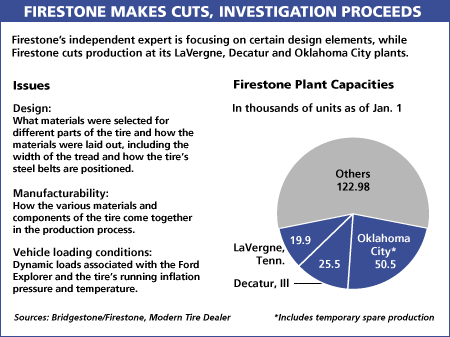
By TIMOTHY AEPPEL and NORIHIKO SHIROUZU
Staff Reporters of THE WALL STREET JOURNAL
Bridgestone/Firestone Inc., in a move that highlights the slump in
demand for its Firestone brand tires in the wake of a massive recall, said
it is laying off about 25% of the hourly work force at its Decatur, Ill.,
factory and temporarily curbing production at that location and two
others.
Meanwhile, the death toll from accidents
involving Firestone tires, mounted mainly on
Ford Motor Co.'s Explorer sport-utility vehicle,
has risen to 119 from 101, federal investigators
said. The National Highway Traffic Safety
Administration also reported more than 500 injuries stemming from
accidents involving the tires, up from 400 a month ago. More than
3,500 complaints about the tires have been filed with the agency, which
is trying to determine whether Firestone's recall should be broadened.
Another 40 or so deaths overseas have been linked to the recalled tires.
Firestone had little choice but to curb production, given its falling tire
sales, a growing mountain of unsold inventory and the company's
weakened reputation following the recall. In order to bolster its finances,
the company needed to trim costs by laying off workers and cutting
output.
Also to move beyond the crisis, Firestone, a unit of Japan's Bridgestone
Corp., must identify what went wrong with the recalled tires and provide
a fixable problem, so that consumers have some assurance that the
company won't continue to make bad tires. This week, Firestone
released a status report from its independent expert, Sanjay Govindjee,
an associate professor at the University of California, Berkeley, who was
hired by Firestone to pinpoint the cause of the tire failures. Mr.
Govindjee expects to submit a preliminary report within a month and a
final report by early next year.
In his status report to Firestone's head of research and development,
Georg Boehm, dated Oct. 12, Mr. Govindjee noted that the problem is
associated with a "complex interaction" of tire design, manufacturing
and the way the tires perform on the Ford Explorer.
Firestone said it will curtail tire production for 28 days between now
and
year end at plants in LaVergne, Tenn., and Oklahoma City. At its
Decatur factory, which produced a large percentage of the recalled tires,
Firestone will lay off 450 workers, or about 25% of the total, and halt
production for 14 days in December. The moves will curtail roughly 20%
of Firestone's total production for the next two months.
"I have made a commitment to our employees and our customers to
rebuild this organization and the Firestone brand," said John Lampe,
newly named as Firestone's chief executive. "In order to keep that
promise, this company must be financially strong and viable.''

Mr. Lampe said tire inventories have bloated to 50% above normal levels
in recent months in anticipation of a possible strike and falling sales.
He
acknowledged that demand has dropped for Firestone brand tires,
though he wouldn't elaborate. Roughly half of the company's sales of
passenger and light-truck tires in the U.S. are under the Firestone
name, while the rest carry names including Bridgestone, Dayton and
private brands.
Mr. Lampe also pointed to a shift in the market, with car makers buying
more larger-size tires. Firestone said the three plants targeted for
cutbacks all produce a disproportionate number of smaller tires. One of
the issues in the recent tire recall was whether Ford and other makers
of SUVs were using too-small passenger-car tires on what were
essentially trucks.
Auto makers are turning to larger wheels for their trucks and
sport-utility trucks. Ford, for instance, will stop offering 15-inch tires
for
the new Explorer and will equip all of the 2002-model-year Explorer,
going on sale early next year, with 16-inch tires. Mr. Lampe says the
production of tires needed for the recall would "continue uninterrupted,"
adding that about 4.2 million of the estimated 6.5 million recalled tires
still on the road have been replaced. The company expects to complete
the recall in November.
Mr. Lampe insisted the layoffs in Decatur don't foreshadow a shutdown.
But he said the company faces a difficult period as it tries to rebuild
its
sales and that the recall has brought about charges that will put the
company in "a deficit position."
In seeking the root cause of the tire failures, Mr. Govindjee found that
small cracks develop inside the tires in a narrow strip of rubber known
as the belt wedge that runs between the edges of the two steel belts.
Over time, these cracks grow and spread through to the entire layer of
rubber between the steel belts -- known as the skim layer -- eventually
leading to the separation of the tread and the upper steel belt from the
rest of the tire.
"All evidence to date points to a slowly developing fatigue crack that
propagates through the belt wedge material and then subsequently into
the belt skim between the steel belts," wrote Mr. Govindjee in his
report. Mr. Govindjee didn't return calls seeking comment on his
investigation.
Dick Baumgardner, a tire expert who often testifies against tire makers
in lawsuits, said he believes the treads on the recalled tires are too
wide
and the corners too squared off, both features of tire geometry that
would add to the buildup of heat in the belt-edge area. The buildup of
heat accelerates the breakdown of rubber.
-- Stephen Power contributed to this article.
Write to Timothy Aeppel at timothy.aeppel@wsj.com and Norihiko
Shirouzu at norihiko.shirouzu@wsj.com